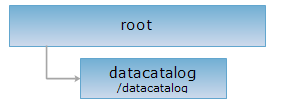
<root_uri>/datacatalog[.<format>]
relationship, sharefile, binary, tiles, spatiotemporal
The datacatalog resource is the entrance to data catalog serveices. By sending GET request to datacatalog resource you can get all supported interfaces of SuperMap iServer datecatalog services.
Supported Methods:
Supported output formats: rjson, json, html, xml.

Implement the HTTP request on the following URI, where supermapiserver is the server name, with rjson being the output format.
http://supermapiserver:8090/iserver/services/datacatalog/rest/datacatalog.rjson
GET: Gets all sub resources supported by datecatalog service.
Send a GET request to datacatalog resource. The responding entity mainly consists of a resource description collection of sub resources.The structure of a single sub resource description is as follows:
| Field | Type | Description |
| name | String | resource name |
| path | String | Resource URL. |
| resourceConfigID | String | The configuration item ID of the resource. |
| resourceType | String | The resource type. |
| supportedMediaTypes | String[] | The media-type of the supported representation. |
The returned rjson format representation after implementing the GET request on the datacatalog resource:
[
{
"name": "relationship",
"path": "http://supermapiserver:8090/iserver/services/datacatalog/rest/datacatalog/relationship",
"resourceConfigID": "relationship",
"resourceType": null,
"supportedMediaTypes": null
},
{
"name": "spatiotemporal",
"path": "http://supermapiserver:8090/iserver/services/datacatalog/rest/datacatalog/spatiotemporal",
"resourceConfigID": "spatiotemporal",
"resourceType": null,
"supportedMediaTypes": null
},
{
"name": "tiles",
"path": "http://supermapiserver:8090/iserver/services/datacatalog/rest/datacatalog/tiles",
"resourceConfigID": "tiles",
"resourceType": null,
"supportedMediaTypes": null
},
{
"name": "sharefile",
"path": "http://supermapiserver:8090/iserver/services/datacatalog/rest/datacatalog/sharefile",
"resourceConfigID": "sharefile",
"resourceType": null,
"supportedMediaTypes": null
}
]
Asks for the response identical to the one that would correspond to a GET request, but without the response body. This is useful for retrieving meta-information contained in response headers, without having to transport the entire content. The meta-information includes the media-type, content-encoding, transfer-encoding, content-length, etc.
HEAD request can be used to check whether the datacatalog resource exists, or whether the the client has the permission to access it. It can also determine if the aggregatePoints resource supports an output format <format> if performed on a URI with .<format> included.